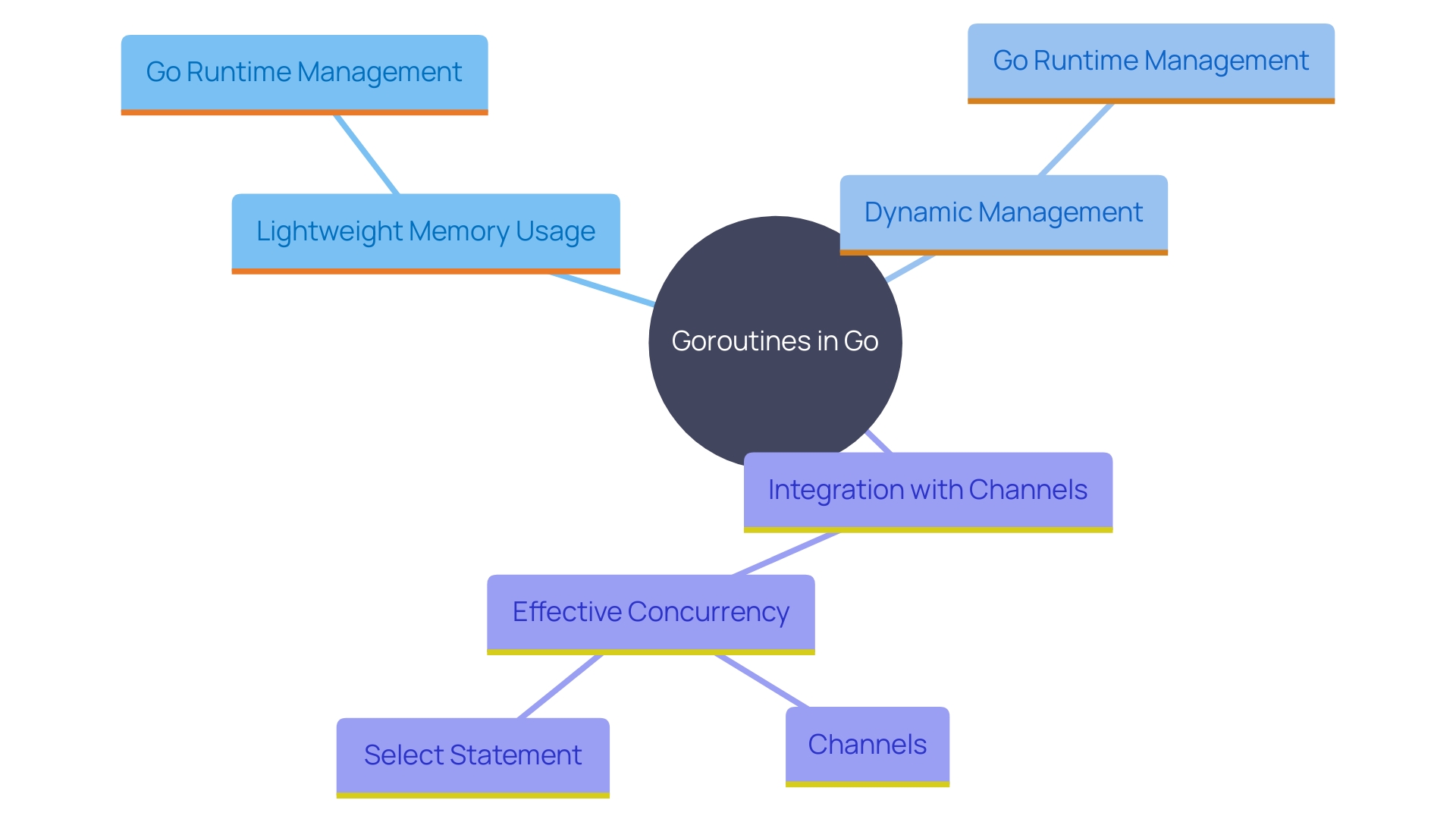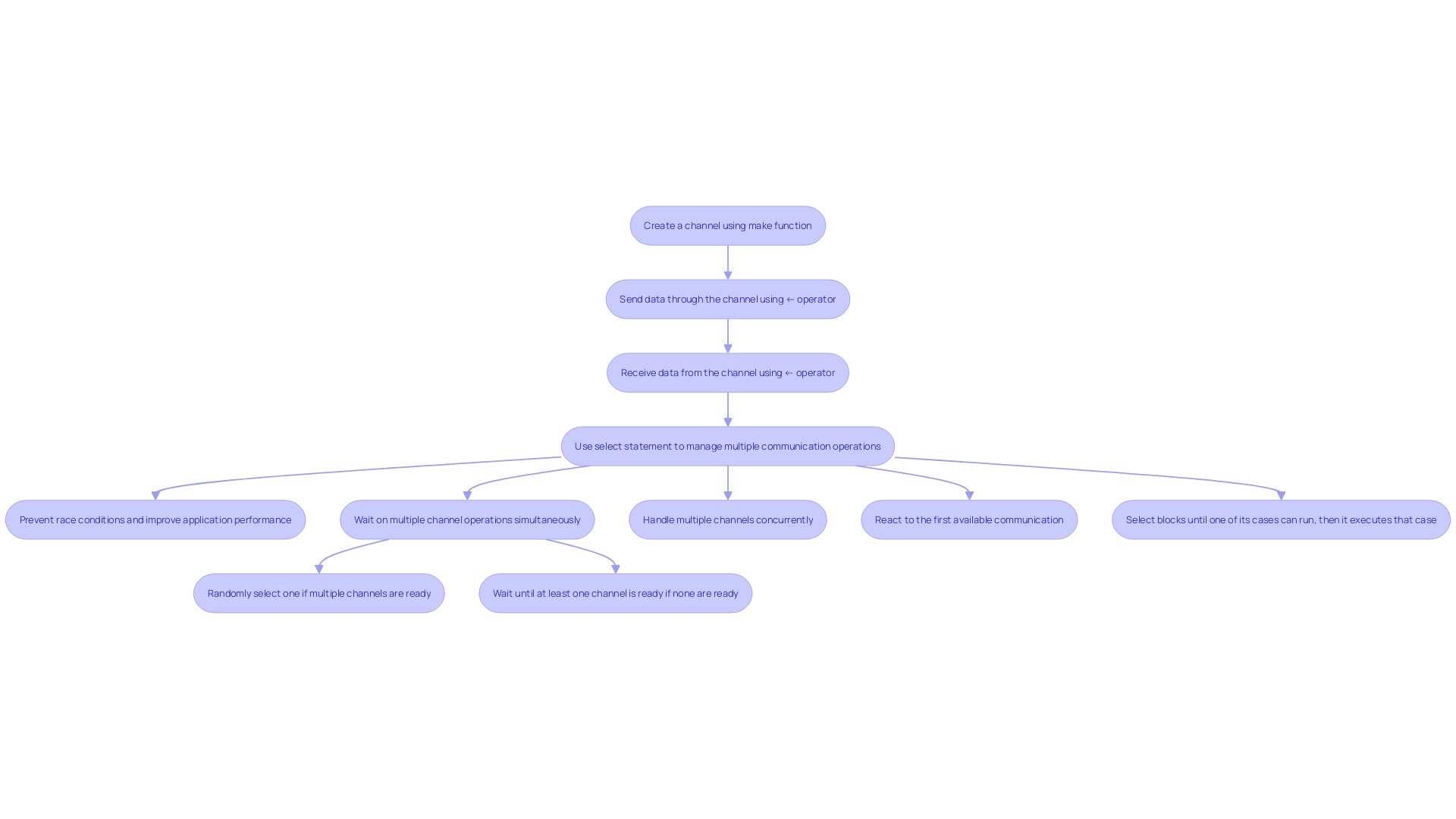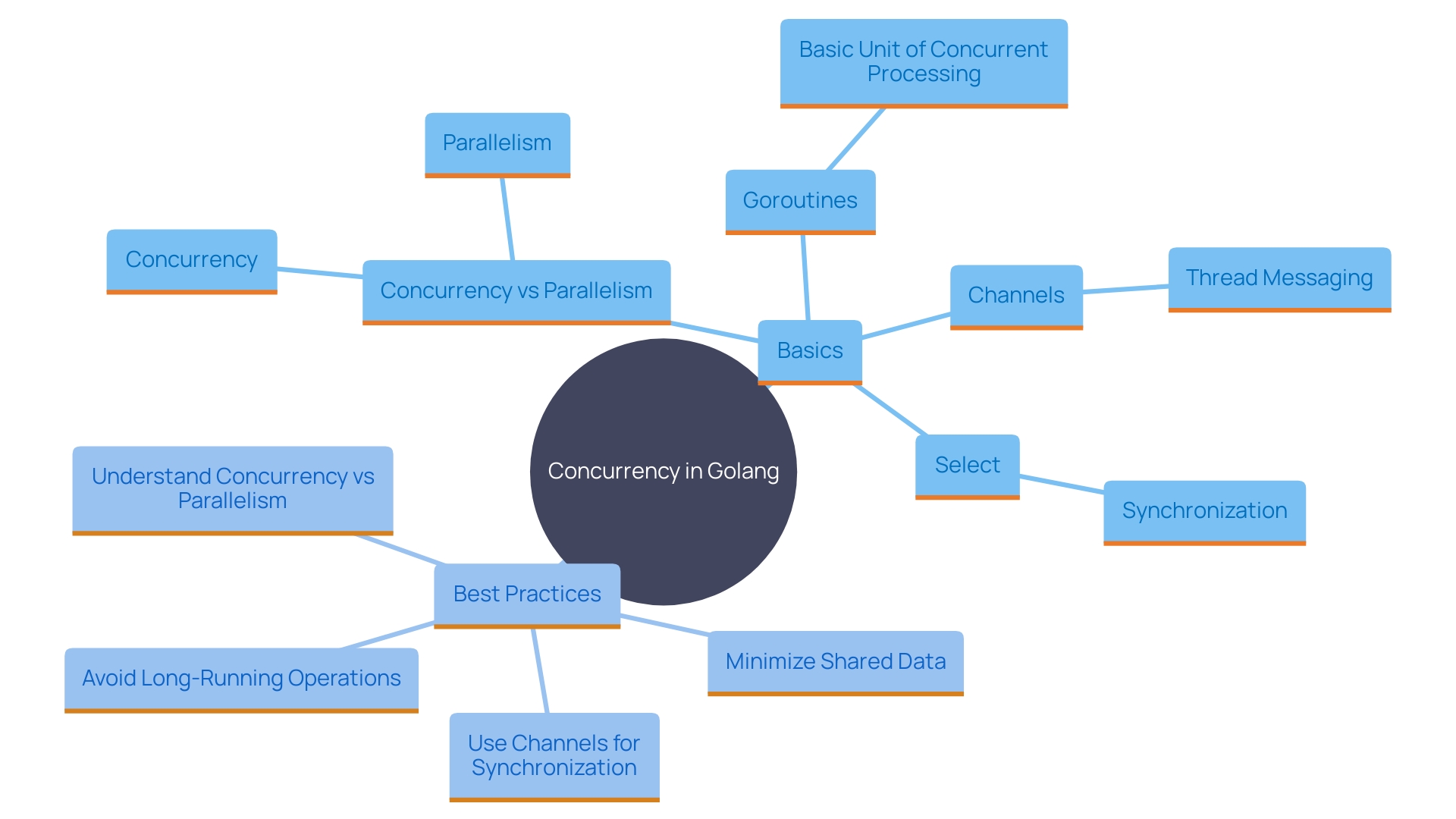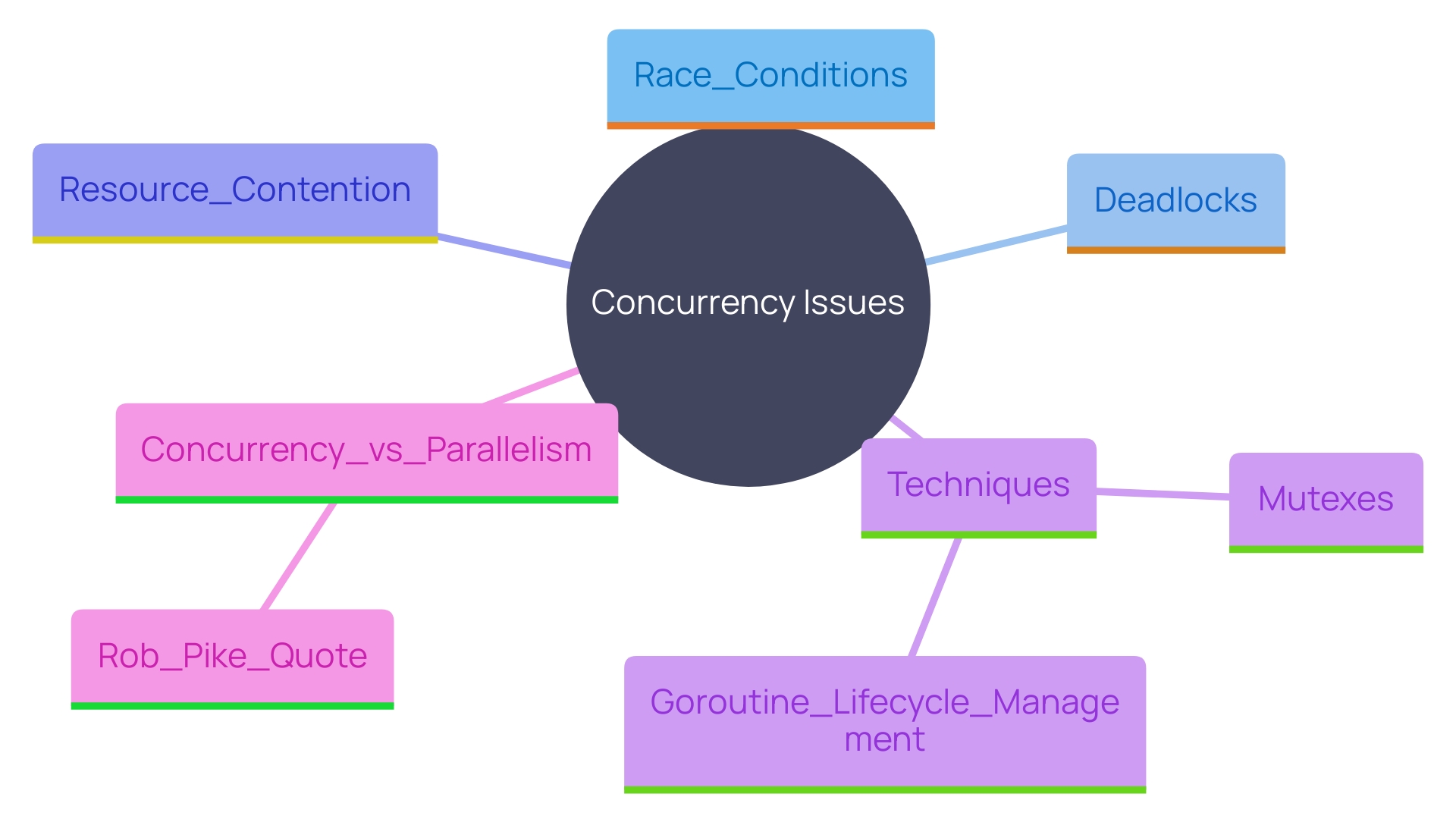Introduction
Concurrency is a vital aspect of Golang development, enabling the execution of multiple tasks within a program simultaneously. This is primarily achieved through goroutines and channels. Goroutines are lightweight threads managed by the Go runtime, providing an efficient way to handle numerous tasks concurrently.
Channels facilitate communication between goroutines, allowing them to synchronize and exchange data seamlessly.
One of the core principles of concurrency in Go is understanding the distinction between concurrency and parallelism. Concurrency involves organizing and managing multiple tasks that overlap in execution, whereas parallelism refers to performing multiple tasks simultaneously. This distinction is crucial for developers to grasp in order to build responsive and efficient applications.
To further illustrate the power of Go's concurrency model, consider the pillars of concurrency: goroutines, channels, and the select statement. The select statement allows a program to wait on multiple communication operations, effectively managing multiple channels and ensuring that the program remains responsive.
Understanding and leveraging these tools and techniques in Go can significantly enhance the performance and responsiveness of applications, making them capable of handling numerous operations concurrently without blocking.
Understanding Concurrency Fundamentals
Concurrency is a vital aspect of Golang development, enabling the execution of multiple tasks within a program simultaneously. This is primarily achieved through goroutines and channels. Goroutines are lightweight threads managed by the Go runtime, providing an efficient way to handle numerous tasks concurrently. Channels facilitate communication between goroutines, allowing them to synchronize and exchange data seamlessly.
One of the core principles of simultaneous execution in Go is understanding the distinction between concurrent processes and parallelism. Concurrency involves organizing and managing several tasks that overlap in execution, whereas parallelism refers to performing various tasks simultaneously. This distinction is crucial for developers to grasp in order to build responsive and efficient applications.
A practical example of simultaneous operations in action is a banking system simulation where several users attempt to withdraw funds from the same account at the same time. Without proper synchronization, this can lead to race conditions, resulting in incorrect balances. By utilizing sync.Mutex, developers can ensure mutual exclusion, allowing only one goroutine to access and modify shared resources at a time, thereby preventing such issues.
To further demonstrate the strength of Go's parallel execution model, consider the pillars of simultaneous processes: goroutines, pathways, and the select statement. The select statement allows a program to wait on multiple communication operations, effectively managing multiple channels and ensuring that the program remains responsive.
Understanding and leveraging these tools and techniques in Go can significantly enhance the performance and responsiveness of applications, making them capable of handling numerous operations concurrently without blocking.
Golang Concurrency Basics
Golang revolutionizes concurrency with its intrinsic support for goroutines. Unlike traditional threads, goroutines are lightweight, starting at just 2KB-4KB, compared to the 2MB typical of threads. This efficiency enables programs to handle numerous simultaneous tasks seamlessly. By simply prefixing a function call with the go keyword, developers can initiate a goroutine, enabling asynchronous execution of functions. This capability is particularly advantageous for handling multiple tasks efficiently.
The Go runtime manages goroutines dynamically, adjusting their size as needed and allocating memory in segmented spaces to prevent system overloads. This dynamic nature ensures optimal performance even under heavy loads. As a result, developers can create robust, simultaneous applications without the complexity associated with traditional threading models.
To fully utilize the power of goroutines, it's important to understand their role within the broader context of simultaneous execution in Go, which also includes channels for inter-goroutine communication and the select statement for synchronization. These elements collectively form the pillars of effective parallelism management in Go, facilitating the development of high-performance, concurrent applications.

Using Channels for Communication
Channels are a cornerstone of concurrency in Golang, enabling efficient communication between goroutines. By utilizing pathways, you can transmit and obtain messages, align tasks, and manage operations effortlessly. To establish a connection, utilize the make function, and for sending or receiving data, employ the <- operator. Channels are instrumental in preventing race conditions and boosting the performance of your applications. For instance, the select statement in Go allows you to handle multiple communication operations simultaneously, ensuring non-blocking interaction between goroutines. This feature is especially useful for intricate simultaneous programming, as it waits until at least one pathway is prepared before moving forward. With the introduction of Go 1.22, the Go community continues to enhance these capabilities, reflecting the evolving needs of developers working with diverse computing architectures and cloud services.

Best Practices for Writing Concurrent Code
When creating simultaneous applications in Golang, following best practices is essential for attaining optimal performance and preserving high code quality. The three pillars of concurrency in Go are Goroutines, conduits, and the select statement. Goroutines act as the fundamental unit of simultaneous processing, enabling several functions to operate at the same time without hindering the execution of the program. Channels facilitate thread messaging, enabling safe communication between Goroutines by passing data seamlessly. The select statement is utilized to coordinate these simultaneous operations, enabling the program to wait on multiple communication operations.
Minimizing shared data is essential to prevent data races and ensure thread safety. Utilizing channels for synchronization additionally aids in attaining efficient and responsive simultaneous systems. Additionally, avoiding long-running operations in Goroutines prevents bottlenecks and ensures that the system remains responsive. Using context for cancellation is another best practice, as it allows for better control over Goroutines, ensuring that they can be terminated gracefully when no longer needed.
Rob Pike, one of the creators of Go, emphasizes the importance of understanding the distinction between concurrency and parallelism. Concurrency involves organizing a lot of tasks at once, while parallelism is about executing many tasks simultaneously. This differentiation is crucial for developers to write efficient simultaneous code. By adhering to these best practices, developers can build robust and efficient concurrent systems in Golang.

Common Pitfalls and Challenges
Concurrency issues such as race conditions, deadlocks, and resource contention are common hurdles for developers. Race conditions alone represent about 80% of all simultaneous execution errors, emphasizing their frequency and effect. To manage these effectively, using mutexes for locking shared data and carefully managing goroutine lifecycles are essential techniques. As Rob Pike, one of Go's creators, noted, "Concurrency is about dealing with lots of things at once. Parallelism is about doing lots of things at once." This distinction highlights the significance of design in simultaneous operations management, ensuring efficient resource usage and application responsiveness. Furthermore, the recent release of Go 1.22 emphasizes the ongoing efforts to provide a stable concurrency environment, showcasing the community's commitment to addressing these challenges. Implementing these techniques not only mitigates issues but also ensures a more stable and reliable application.

Conclusion
The exploration of concurrency in Golang reveals its pivotal role in creating efficient and responsive applications. By utilizing goroutines, developers can execute multiple tasks concurrently without the overhead associated with traditional threading models. This lightweight approach to concurrency, combined with the dynamic management of goroutines by the Go runtime, enables the handling of numerous operations seamlessly.
Channels serve as a fundamental mechanism for communication between goroutines, facilitating synchronization and preventing race conditions. The ability to send and receive messages through channels enhances the overall performance of applications, making them more robust and capable of managing complex operations. The integration of the select statement further empowers developers to manage multiple channel operations effectively, ensuring non-blocking communication and responsiveness.
Adhering to best practices, such as minimizing shared data and leveraging context for cancellation, is crucial for maintaining high code quality and optimal performance in concurrent programming. By understanding the distinctions between concurrency and parallelism, developers can design applications that not only meet performance expectations but also remain stable and reliable. The ongoing enhancements in Go, particularly with the release of Go 1.22, reflect a commitment to addressing the challenges of concurrency, allowing developers to build sophisticated systems that harness the full potential of Go's concurrency model.
Frequently Asked Questions
What is concurrency in Golang?
Concurrency in Golang refers to the ability to execute multiple tasks simultaneously within a program. This is primarily facilitated through goroutines and channels, which allow for efficient handling of multiple tasks without blocking.
What are goroutines?
Goroutines are lightweight threads managed by the Go runtime. They provide an efficient way to run functions concurrently, starting with a small memory footprint of just 2KB-4KB, compared to the 2MB typical of traditional threads.
How do channels work in Golang?
Channels are used for communication between goroutines. They allow goroutines to synchronize and exchange data seamlessly. You can create a channel using the make function and use the <- operator to send and receive data.
What is the difference between concurrency and parallelism?
Concurrency involves managing multiple tasks that overlap in execution, while parallelism refers to executing multiple tasks simultaneously. Understanding this distinction is crucial for developers to build responsive applications.
What is the purpose of the select statement in Go?
The select statement is used to wait on multiple communication operations, effectively managing multiple channels and ensuring the program remains responsive when handling concurrent tasks.
How can race conditions be prevented in Golang?
Race conditions can be prevented by utilizing synchronization techniques such as sync.Mutex, which ensures that only one goroutine can access and modify shared resources at a time. This helps maintain correct data integrity.
What are some best practices for writing concurrent applications in Golang?
Best practices include minimizing shared data, using channels for synchronization, avoiding long-running operations in goroutines, and employing context for cancellation to manage goroutine lifecycles effectively.
What common issues do developers face with concurrency?
Common issues include race conditions, deadlocks, and resource contention. Race conditions are particularly prevalent, representing about 80% of concurrency-related errors.
How has the Go community responded to concurrency challenges?
The Go community continuously enhances concurrency capabilities, as seen in recent releases like Go 1.22, which aim to provide a stable and efficient concurrency environment for developers.
Why is it important to understand concurrency and parallelism in Go?
Understanding the difference between concurrency and parallelism is essential for developers to write efficient code, optimize resource usage, and ensure application responsiveness in concurrent systems.




